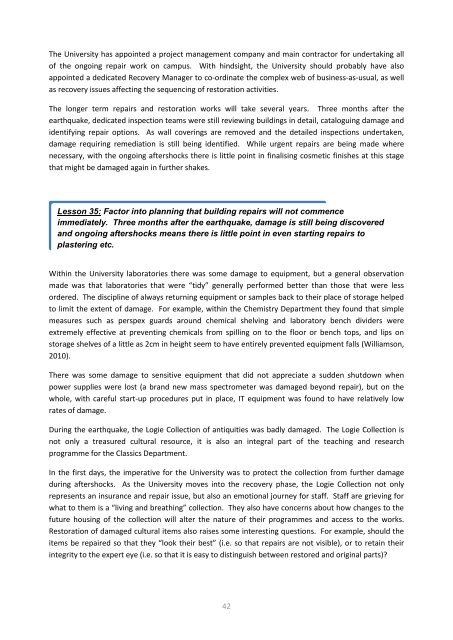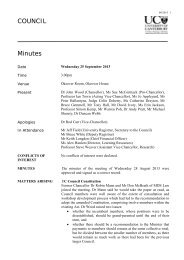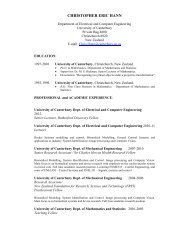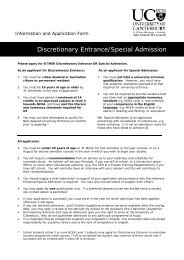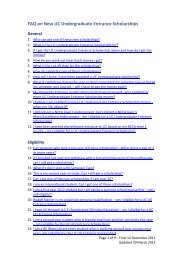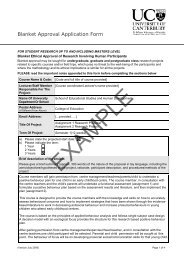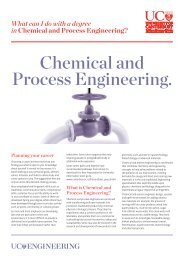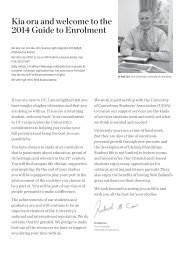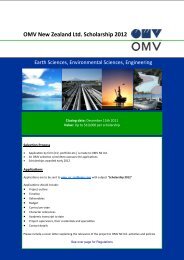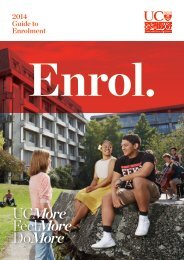Shaken but not Stirred - University of Canterbury
Shaken but not Stirred - University of Canterbury
Shaken but not Stirred - University of Canterbury
You also want an ePaper? Increase the reach of your titles
YUMPU automatically turns print PDFs into web optimized ePapers that Google loves.
The <strong>University</strong> has appointed a project management company and main contractor for undertaking all<br />
<strong>of</strong> the ongoing repair work on campus. With hindsight, the <strong>University</strong> should probably have also<br />
appointed a dedicated Recovery Manager to co-ordinate the complex web <strong>of</strong> business-as-usual, as well<br />
as recovery issues affecting the sequencing <strong>of</strong> restoration activities.<br />
The longer term repairs and restoration works will take several years. Three months after the<br />
earthquake, dedicated inspection teams were still reviewing buildings in detail, cataloguing damage and<br />
identifying repair options. As wall coverings are removed and the detailed inspections undertaken,<br />
damage requiring remediation is still being identified. While urgent repairs are being made where<br />
necessary, with the ongoing aftershocks there is little point in finalising cosmetic finishes at this stage<br />
that might be damaged again in further shakes.<br />
Lesson 35: Factor into planning that building repairs will <strong>not</strong> commence<br />
immediately. Three months after the earthquake, damage is still being discovered<br />
and ongoing aftershocks means there is little point in even starting repairs to<br />
plastering etc.<br />
Within the <strong>University</strong> laboratories there was some damage to equipment, <strong>but</strong> a general observation<br />
made was that laboratories that were “tidy” generally performed better than those that were less<br />
ordered. The discipline <strong>of</strong> always returning equipment or samples back to their place <strong>of</strong> storage helped<br />
to limit the extent <strong>of</strong> damage. For example, within the Chemistry Department they found that simple<br />
measures such as perspex guards around chemical shelving and laboratory bench dividers were<br />
extremely effective at preventing chemicals from spilling on to the floor or bench tops, and lips on<br />
storage shelves <strong>of</strong> a little as 2cm in height seem to have entirely prevented equipment falls (Williamson,<br />
2010).<br />
There was some damage to sensitive equipment that did <strong>not</strong> appreciate a sudden shutdown when<br />
power supplies were lost (a brand new mass spectrometer was damaged beyond repair), <strong>but</strong> on the<br />
whole, with careful start-up procedures put in place, IT equipment was found to have relatively low<br />
rates <strong>of</strong> damage.<br />
During the earthquake, the Logie Collection <strong>of</strong> antiquities was badly damaged. The Logie Collection is<br />
<strong>not</strong> only a treasured cultural resource, it is also an integral part <strong>of</strong> the teaching and research<br />
programme for the Classics Department.<br />
In the first days, the imperative for the <strong>University</strong> was to protect the collection from further damage<br />
during aftershocks. As the <strong>University</strong> moves into the recovery phase, the Logie Collection <strong>not</strong> only<br />
represents an insurance and repair issue, <strong>but</strong> also an emotional journey for staff. Staff are grieving for<br />
what to them is a “living and breathing” collection. They also have concerns about how changes to the<br />
future housing <strong>of</strong> the collection will alter the nature <strong>of</strong> their programmes and access to the works.<br />
Restoration <strong>of</strong> damaged cultural items also raises some interesting questions. For example, should the<br />
items be repaired so that they “look their best” (i.e. so that repairs are <strong>not</strong> visible), or to retain their<br />
integrity to the expert eye (i.e. so that it is easy to distinguish between restored and original parts)?<br />
42


